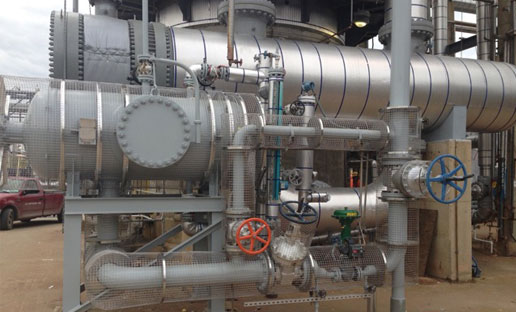BENEFITS:
CUI PREVENTION
The National Board of Boiler and Pressure Vessel Inspectors identify the types of Corrosion Under Insulation (CUI)
as galvanic,alkaline /acidic, and chloride stress corrosion. It also quotes:
- Galvanic corrosion generally results from wet insulation with an electrolyte or salt present that allows a current to flow between dissimilar metals.
- Alkaline or Acidic corrosion results when an alkali or acid and moisture are present in certain fibrous or granular insulations.
- Chloride corrosion can be caused the combination of insulation containing leachable chlorides with the 300 series of austenitic stainless steel surfaces, when moisture is present and temperatures are above 140F.
Moisture or water infiltrating the protection of the insulation is required and the main cause of all types of corrosion under insulation or CUI. The moisture protection, (usually an aluminum jacket) can be compromised by a number of usual reasons and also some others.
Usual reasons include:
- Someone walking on the insulation.
- Tying off for fall protection.
- Resting equipment on the pipe during maintenance or project work.
- A ladder being put up against the pipe.
- Poor installation where the seams are not tight or overlapped properly
(In the vertical it needs to be installed like shingles and in the horizontal with the overlap at the 90 degree mark with the overlap on top).
- A tool being dropped on a seam causing a dent.
- Thermal expansion & contraction.
- Seismic activity.
- Vibration from rotating equipment.
- Vibration from poorly designed systems or a change of service leading to high velocities, high pressure drop, or hammer.
- Wildlife walking on, landing on, defecating on, or steeling materials for a nest.
- Just plain old insulation well past its design life.
- UT reading locations where the mastic dries and cracks or plugs get weathered. API 570, the same inspection code that requires regular thickness readings, suggests that inspector pay particular attention to the location that have been tested before for this very reason.
Once moisture gets under the protective shell, the same properties that makes the insulation perform well, which is holding air spaces then changes into a detriment. Once wet, most types of insulation have the properties that turn into a wicking function that hold moisture/water on the pipe surface that is the most vulnerable. Once the system has been infiltrated, every time it rains, a steam trap discharges onto the same location, water is used to cool the exterior of a system, or fire water lines are purged, the moisture travels to the same localized corroding location. Regular inspections attempt to and sometimes anticipate corrosion issues. However most (possibly all) CUI does not happen uniformly with a classroom/textbook metal loss but in one problem area.

With high temperature systems (Above 250F average or 212F specific), the moisture vaporizes off. It still destroys the insulation properties from functioning properly but typically does not have a localized corrosion issue due to its temperature. The lower temperature situations have a different issue. The combination of moisture repeatedly relocating to the same spot with the heat is like a catalyst for accelerated corrosion, a frenzy if you will. It's the perfect condition for advanced accelerated localized corrosion. Of course the result is the degradation of the piping circuit to
maintain its pressure and a failure occurs. This leads to loss of containment and subsequent fires, explosions, environmental releases, gassing of personnel, repair costs, shutting down a unit and the LPO thereof, and potential injury, death, and surrounding community issues.
The Envirocage technology is predominately applied to the lower temperature systems since higher temperature application would be designed with economizers.
With the E-cage, there is no insulation, so there is simply no CUI. And again, this is applied to the most vulnerable circuits.
The Envirocage technology is predominately applied to the lower temperature systems since higher temperature application would be designed with economizers.
With the E-cage, there is no insulation, so there is simply no CUI. And again, this is applied to the most vulnerable circuits.
